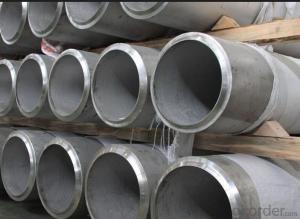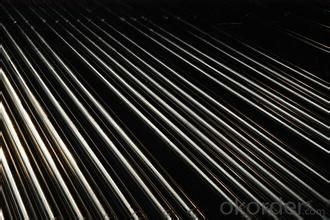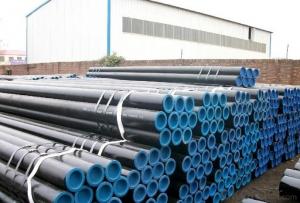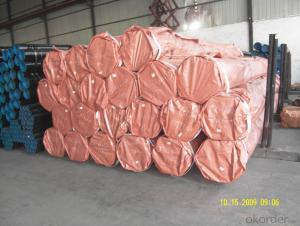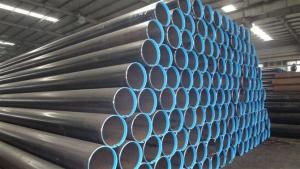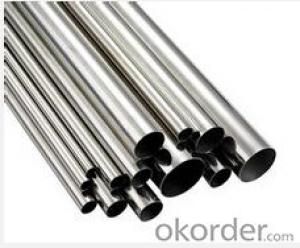Stainless Seamless Round Hot Rolled Pipe
- Loading Port:
- China main port
- Payment Terms:
- TT or LC
- Min Order Qty:
- 100 m.t.
- Supply Capability:
- 10000 m.t./month
OKorder Service Pledge
OKorder Financial Service
You Might Also Like
1、Structure of Seamless Pipe :
Seamless pipe is regarded as withstanding pressure better than other types, and was often more easily available than welded pipe.
2、Main Features of the Seamless Pipe :
• Strong heat dissipation ability
• Good visual effect
• Reasonable price
• High manufacturing accuracy
• High strength
• Small inertia resistance
3、Seamless Pipe Specification:
Standard | GB, DIN, ASTM ASTM A106-2006, ASTM A53-2007 |
Grade | 10#-45#, 16Mn 10#, 20#, 45#, 16Mn |
Thickness | 8 - 33 mm |
Section Shape | Round |
Outer Diameter | 133 - 219 mm |
Place of Origin | Shandong, China (Mainland) |
Secondary Or Not | Non-secondary |
Application | Hydraulic Pipe |
Technique | Cold Drawn |
Certification | API |
Surface Treatment | factory state or painted black |
Special Pipe | API Pipe |
Alloy Or Not | Non-alloy |
Length | 5-12M |
Outer Diameter | 21.3-610mm |
Grade | 20#, 45#, Q345, API J55, API K55, API L80, API N80, API P110, A53B |
Standard | ASME, ASTM |
1) Material:20#(ASTM A 106/A53 GRB.API5LGRB,GB),45#,16Mn,10#.
2) Specification range:OD:21.3-610mm,WT:6-70mm,length:6-12m or according to the requirement of clients.
3) Excutive standards:GB,ASME API5L.ASTM A 106/A53,Despite of the above standards,we can also supply seamless steel pipe with standard of DIN,JIS,and so on,and also develop new products according to the requirements of our clients!
4) Surface:black lacquered,varnish coating or galvanized.
5) Ends:Beveled or square cut,plastic capped,painted.
6) Packing:bundles wrapped with strong steel strip,seaworthy packing.
4、Packaging & Delivery
Packaging Details: | seaworthy package,bundles wrapped with strong steel strip |
Delivery Detail: | 15-30days after received 30%TT |
5、FAQ of Seamless Pipe :
①How is the quality of your products?
Our products are manufactured strictly according to national and internaional standard, and we take a test on every pipe before delivered out. Guaranteed: If products’ quality don’t accord to discription as we give or the promise before you place order, we promise 100% refund.
②How about price?
We are factory and be able to give you lowest price below market one, and we have a policy that “ for saving time and absolutely honest business attitude.Please trust the quotation we would give you, it is professional one.
③Why should you chose us?
Chose happens because of quality, then price, We can give you both.Additionally, we can also offer professional products inquiry, products knowledge train(for agents), smooth goods delivery, exellent customer solution proposals.Our service formula: good quality+good price+good service=customer’s trust
SGS test is available, customer inspection before shipping is welcome, third party inspection is no problem.
Any question, pls feel free to contact us !
6、Seamless Pipe
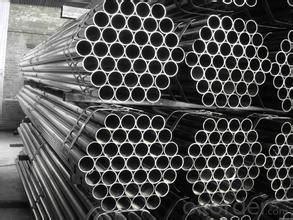
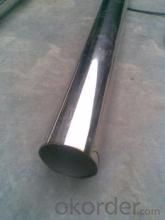
Images:
- Q: Can stainless steel pipes be used for cryogenic applications?
- Cryogenic applications can indeed utilize stainless steel pipes. Stainless steel is widely recognized for its exceptional properties at low temperatures, including admirable strength, flexibility, and resistance against corrosion. These qualities render stainless steel pipes suitable for the transportation and storage of cryogenic fluids, like liquid nitrogen, oxygen, or argon. The high strength-to-weight ratio of stainless steel permits the construction of lightweight and durable cryogenic systems. Furthermore, stainless steel pipes can endure the extreme temperature gradients and thermal stresses commonly encountered in cryogenic applications. Nevertheless, it is crucial to select the appropriate grade of stainless steel specifically engineered for cryogenic service to ensure optimal performance and safety.
- Q: Can stainless steel pipes be stress relieved?
- Indeed, it is possible to subject stainless steel pipes to stress relieving. Stress relieving is a method of heat treatment employed to diminish stress-induced distortion and enhance the mechanical characteristics of the material. Typically, stainless steel pipes can be subjected to stress relieving at elevated temperatures, generally ranging from 900°C to 1050°C (1652°F to 1922°F), followed by gradual cooling. By doing so, residual stresses that may have been incurred during manufacturing processes like welding or forming can be alleviated. Furthermore, stress relieving can augment the corrosion resistance and overall performance of stainless steel pipes.
- Q: What is the difference between 17-4 and 15-5 stainless steel pipes?
- The main difference between 17-4 and 15-5 stainless steel pipes lies in their composition and properties. 17-4 stainless steel is a precipitation-hardening alloy that contains around 17% chromium and 4% nickel. It also includes significant amounts of copper, niobium, and tantalum, which contribute to its high strength and corrosion resistance. 17-4 stainless steel pipes are known for their excellent mechanical properties, making them ideal for applications that require high strength and toughness. They are commonly used in industries such as aerospace, defense, and oil and gas. On the other hand, 15-5 stainless steel is also a precipitation-hardening alloy, but it contains around 15% chromium and 5% nickel. It has a higher copper content compared to 17-4 stainless steel. The addition of copper in 15-5 stainless steel enhances its resistance to corrosion and improves its toughness. These pipes are often used in applications where a combination of strength, corrosion resistance, and good formability is required. They find applications in industries such as marine, chemical processing, and food processing. In summary, while both 17-4 and 15-5 stainless steel pipes are precipitation-hardening alloys, the difference lies in their chromium, nickel, and copper content. 17-4 stainless steel offers higher strength and toughness, making it suitable for demanding applications. 15-5 stainless steel, with its increased copper content, provides enhanced corrosion resistance and formability, making it a preferred choice for certain industries.
- Q: What are the different types of stainless steel pipe coatings?
- There are several types of stainless steel pipe coatings that are used to enhance the durability, corrosion resistance, and aesthetic appearance of the pipes. Some of the common types of stainless steel pipe coatings include: 1. Fusion Bonded Epoxy (FBE) Coating: FBE coating is a thermosetting resin-based coating that is applied to the pipes using an electrostatic spray. It provides excellent corrosion resistance and adhesion, making it suitable for both buried and above-ground applications. 2. Polyethylene (PE) Coating: PE coating is a thermoplastic coating that is applied to the pipes using extrusion. It provides high impact resistance and excellent resistance to chemical substances, making it suitable for pipes used in harsh environments. 3. Polypropylene (PP) Coating: PP coating is a thermoplastic coating similar to PE coating but with higher temperature resistance. It is often used for pipes that transport high-temperature fluids. 4. Polyurethane (PU) Coating: PU coating is a thermosetting resin-based coating that is applied to the pipes using a spray or dip method. It provides excellent resistance to abrasion, impact, and chemicals, making it suitable for pipes used in demanding applications. 5. Zinc Coating: Zinc coating, also known as galvanization, is a metallic coating that is applied to the pipes using a hot-dip process. It provides excellent corrosion resistance and is commonly used for pipes used in outdoor and underground applications. 6. Ceramic Coating: Ceramic coating is a high-temperature resistant coating that is applied to the pipes using a thermal spray process. It provides excellent resistance to abrasion, oxidation, and corrosion, making it suitable for pipes used in high-temperature environments. 7. PTFE (Polytetrafluoroethylene) Coating: PTFE coating is a non-stick coating that is applied to the pipes using a spray or dip method. It provides excellent resistance to chemicals and high temperatures, making it suitable for pipes used in the chemical and food industries. These are just a few examples of the different types of stainless steel pipe coatings available. The choice of coating depends on the specific requirements of the application, such as the type of fluid being transported, the operating temperature and pressure, and the environmental conditions.
- Q: Can stainless steel pipes be used for underground irrigation systems?
- Yes, stainless steel pipes can be used for underground irrigation systems. Stainless steel is highly resistant to corrosion, making it a durable and long-lasting option for underground applications. It can withstand the moisture and soil conditions typically found in irrigation systems, ensuring reliable and efficient water distribution.
- Q: What are the common industry standards for stainless steel pipes?
- The common industry standards for stainless steel pipes include ASTM A312/A312M for seamless and welded pipes, ASTM A269 for seamless and welded tubes, and ASME B36.19M for stainless steel pipe dimensions. These standards ensure the quality, dimensions, and performance of stainless steel pipes in various applications.
- Q: Are stainless steel pipes suitable for beer brewing applications?
- Yes, stainless steel pipes are highly suitable for beer brewing applications. Stainless steel is corrosion-resistant, ensuring the purity and quality of the beer. It also has excellent heat resistance, making it suitable for various brewing processes such as boiling and fermentation. Additionally, stainless steel is easy to clean and maintain, ensuring hygienic conditions throughout the brewing process.
- Q: How do stainless steel pipes compare to fiberglass pipes?
- Distinct characteristics and advantages set stainless steel pipes and fiberglass pipes apart. When comparing the two, one must consider factors such as strength, durability, corrosion resistance, cost, and ease of installation. In terms of strength, stainless steel pipes have a clear advantage, known for their exceptional strength and durability. They can withstand high-pressure applications and heavy loads. On the other hand, fiberglass pipes are relatively weaker and may not be suitable for high-strength and resistance applications. Durability is another crucial aspect. Stainless steel pipes are highly durable, enduring extreme temperatures, chemicals, and physical stress without deteriorating. Fiberglass pipes, though durable, are more susceptible to damage from impact, extreme temperatures, and UV radiation. Therefore, stainless steel pipes are a more reliable choice for long-term use in harsh environments. Corrosion resistance is significant when selecting pipes. Stainless steel pipes are renowned for their excellent corrosion resistance, making them ideal for applications where exposure to corrosive substances is a concern. Fiberglass pipes, while relatively resistant to many chemicals, can be affected by certain corrosive substances and may require additional protective coatings. Cost is an important consideration for any project. Due to the higher cost of raw materials and manufacturing processes, stainless steel pipes tend to be more expensive than fiberglass pipes. Conversely, fiberglass pipes are generally more affordable, making them a cost-effective option for budget-constrained projects. Finally, ease of installation is worth mentioning. The weight and rigidity of stainless steel pipes require specialized tools and expertise for installation. In contrast, fiberglass pipes being lightweight and flexible, are easier to handle and install, reducing labor costs and time. In conclusion, stainless steel pipes offer superior strength, durability, and corrosion resistance compared to fiberglass pipes. However, fiberglass pipes are a more cost-effective option and easier to install. Ultimately, the choice between the two depends on the specific project requirements, considering factors such as application, budget, and environmental conditions.
- Q: Can stainless steel pipes be used in chemical processing plants?
- Yes, stainless steel pipes can be used in chemical processing plants. Stainless steel is highly resistant to corrosion, making it suitable for handling various chemicals and corrosive substances commonly found in such plants. Additionally, stainless steel pipes offer high strength, durability, and versatility, making them a preferred choice for conveying fluids and gases in chemical processing industries.
- Q: What are the cost considerations for stainless steel pipes?
- The cost considerations for stainless steel pipes include the initial purchase price, installation costs, maintenance expenses, and potential long-term savings due to their durability and corrosion resistance. Additionally, factors such as the grade, size, and quantity of pipes needed and any additional fabrication or customization requirements can also impact the overall cost.
Send your message to us
Stainless Seamless Round Hot Rolled Pipe
- Loading Port:
- China main port
- Payment Terms:
- TT or LC
- Min Order Qty:
- 100 m.t.
- Supply Capability:
- 10000 m.t./month
OKorder Service Pledge
OKorder Financial Service
Similar products
Hot products
Hot Searches
Related keywords
